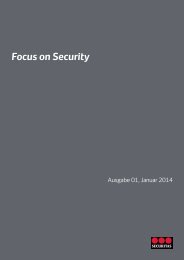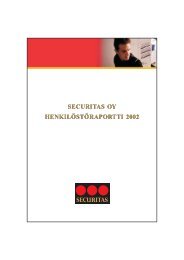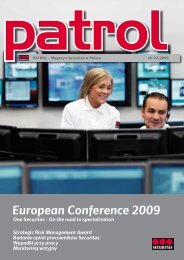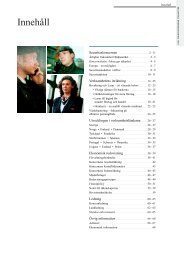SECURITAS AB Annual Report 2011
SECURITAS AB Annual Report 2011
SECURITAS AB Annual Report 2011
Create successful ePaper yourself
Turn your PDF publications into a flip-book with our unique Google optimized e-Paper software.
78 <strong>Annual</strong> <strong>Report</strong><br />
Notes and comments to the consolidated financial statements<br />
ment of income named acquisition related costs. Costs accounted for on this<br />
line are transaction costs, revaluation (including discounting) of contingent<br />
considerations and acquisition related option liabilities, revaluation to fair value<br />
of previously acquired shares in step acquisitions and acquisition related<br />
restructuring and integration costs.<br />
For all acquisitions, the excess of the cost of acquisition over the fair value<br />
of the Group’s share of the identifiable net assets acquired is recorded as<br />
goodwill. If the cost of acquisition is less than the fair value of the net assets<br />
of the subsidiary acquired, the difference is recognized directly in the consolidated<br />
statement of income.<br />
The consolidated financial statements include companies acquired with<br />
effect from the date that the Group obtains control. Companies divested are<br />
excluded with effect from the date that the Group ceases to have control.<br />
Pricing of deliveries among Group companies is based on normal business<br />
principles. Inter-company transactions, balances and unrealized gains between<br />
Group companies are eliminated. Unrealized losses are also eliminated unless<br />
the transaction provides evidence of an impairment of the asset transferred.<br />
Non-controlling interests (IAS 27)<br />
For acquisitions made before 2010, the Group has adopted the principle of<br />
treating transactions with non-controlling interests as transactions with parties<br />
outside the Group. Acquisitions of non-controlling interests give rise to<br />
goodwill that is determined as the difference between the purchase price<br />
paid and the acquired share of the book value of the subsidiaries’ net assets.<br />
Disposals of non-controlling interests result in gains and losses for the<br />
Group and are recognized via the statement of income. When the Group<br />
ceases to have control over an entity, the carrying amount of the investment<br />
at the date the control was lost becomes its cost for the purposes of subsequently<br />
accounting for the retained interest.<br />
for acquisitions made as from 2010 the Group treats transactions with<br />
non-controlling interests as transactions with equity owners of the Group.<br />
For acquisitions from non-controlling interests, the difference between any<br />
consideration paid and the relevant share acquired of the carrying value of<br />
net assets of the subsidiary is recorded in equity. Gains or losses on disposals<br />
to non-controlling interests are also recorded in equity. When the Group<br />
ceases to have control, any retained interest in the entity is remeasured to<br />
its fair value, with the change in carrying amount recognized in the statement<br />
of income. The fair value is the initial carrying amount for the purposes<br />
of subsequently accounting for the retained interest.<br />
Investments in associates (IAS 28)<br />
The equity method is used to account for shareholdings that are neither subsidiaries<br />
nor joint ventures, but where Securitas can exert a significant influence,<br />
generally accompanying a shareholding of between 20 percent and 50<br />
percent of the voting rights. For acquisitions made before 2010, the cost of<br />
an acquisition is measured at the fair value of the assets given, any contingent<br />
considerations and acquisition related option liabilities that have been<br />
estimated, equity instruments issued and liabilities incurred or assumed at<br />
the date of exchange, plus costs directly attributable to the acquisition.<br />
Identifiable assets acquired and liabilities and contingent liabilities assumed<br />
as a result of the acquisition are measured initially at their fair values at the<br />
acquisition date.<br />
For acquisitions made as from 2010, all payments to acquire a business<br />
are recorded at fair value at the acquisition date, with contingent considerations<br />
and acquisition related option liabilities classified as debt subsequently<br />
re-measured through the statement of income. All acquisition<br />
related transaction costs are expensed.<br />
For all acquisitions, the excess of the cost of acquisition over the fair value<br />
of the Group’s share of the identifiable net assets acquired is attributed to<br />
goodwill, which is included in investments in associated companies in the<br />
consolidated balance sheet. If the cost of acquisition is less than the fair<br />
value of the net assets of the associated company acquired, the difference is<br />
recognized directly in the consolidated statement of income.<br />
Securitas <strong>Annual</strong> <strong>Report</strong> <strong>2011</strong><br />
The consolidated financial statements include associated companies<br />
with effect from the date of the acquisition. Associated companies divested<br />
are excluded with effect from the divestment date. If the ownership interest<br />
in an associate is reduced but significant influence is retained, only a proportionate<br />
share of the amounts previously recognized in other comprehensive<br />
income are reclassified to the statement of income where appropriate.<br />
Inter-company transactions, balances and unrealized gains between the<br />
Group and its associated companies are eliminated to the extent of the<br />
Group’s interest in the associate. Unrealized losses are also eliminated<br />
unless the transaction provides evidence of an impairment of the asset<br />
transferred.<br />
Share in income of associated companies is recognized in the consolidated<br />
statement of income. Depending on the purpose of the investment<br />
share in income of associated companies is included either in operating<br />
income, if it is related to associated companies that have been acquired to<br />
contribute to the operations (operational), or in income before taxes as a<br />
separate line within net financial items, if it is related to associated companies<br />
that have been acquired as part of the financing of the Group (financial<br />
investments). In both cases the share in income of associated companies<br />
are net of tax. The associated companies Long Hai Security Services Joint<br />
Stock Company and Walsons Services Pvt Ltd are classified as operational<br />
associates. Facility Network A/S, which is classified as an operational associate<br />
in the comparatives, was divested in 2009.<br />
In the consolidated balance sheet, investments in associated companies<br />
are stated at cost including the cost of the acquisition that is attributed to<br />
goodwill, adjusted for dividends and the share of income after the acquisition<br />
date.<br />
Joint ventures (IAS 31)<br />
The proportional method is applied to joint ventures in which there is a<br />
shared controlling interest. According to this method, all statement of income<br />
and balance sheet items are stated in the consolidated statement of income,<br />
the consolidated statement of cash flow and the consolidated balance sheet<br />
in proportion to ownership. The proportional method of consolidation is used<br />
with effect from the date when a shared controlling interest is achieved and<br />
up until a shared controlling interest ceases to exist.<br />
Translation of foreign subsidiaries (IAS 21)<br />
The functional currency of each Group company is determined by the primary<br />
economic environment in which the company operates, that is the<br />
currency in which the company primarily generates and expends cash. The<br />
functional currency of the Parent Company and the presentation currency<br />
of the Group, that is the currency in which the financial statements are<br />
presented, is Swedish kronor (SEK).<br />
The financial statements of each foreign subsidiary are translated according<br />
to the following method: Each month’s statement of income is translated<br />
using the exchange rate prevailing on the last day of the month, which means<br />
that income for each month is not affected by foreign exchange fluctuations<br />
during subsequent periods. Balance sheets are translated using exchange<br />
rates prevailing at each balance sheet date. Translation differences arising in<br />
the conversion of balance sheets are posted directly to other comprehensive<br />
income and thus do not affect net income for the year. The translation difference<br />
arising because statements of income are translated using average<br />
rates, while balance sheets are translated using exchange rates prevailing at<br />
each balance sheet date, is posted directly to other comprehensive income.<br />
Where loans have been raised to reduce the Group’s foreign exchange /<br />
translation exposure in foreign net assets, and qualify for the hedge accounting<br />
criteria, exchange rate differences on such loans are recognized together<br />
with the exchange rate differences arising from the translation of foreign net<br />
assets in other comprehensive income. The accumulated translation differences<br />
are accounted for in translation reserve in equity. When a foreign<br />
operation or part thereof is sold, such exchange differences are recognized<br />
in the statement of income as part of the gain or loss on sale.

















